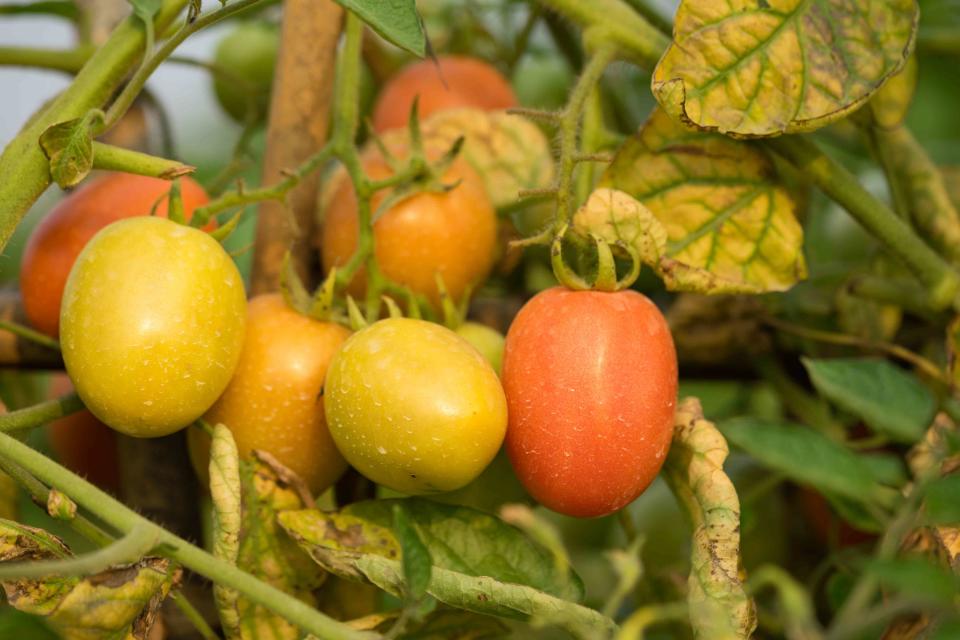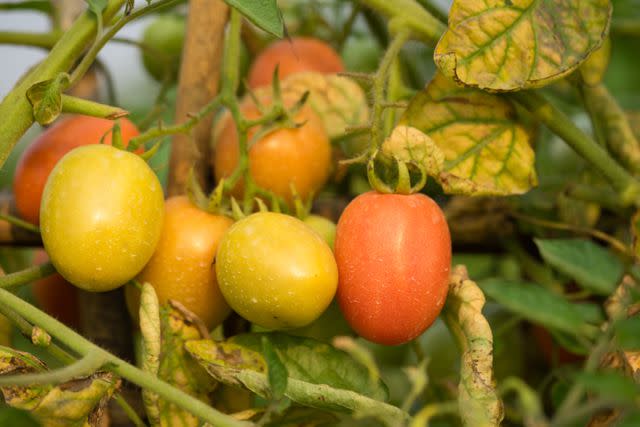Got Yellow Leaves on Tomato Plants? 9 Reasons Why and How to Fix It
Yellow leaves signal a problem. Here's how to figure out what's going on.

vinhdav / Getty Images
Yellow leaves on tomato plants are a sign that there's a problem. The cause might be a disease or pest attacking your tomatoes or it might be a troublesome aspect of the environment or plant care. There is good news—most of the time the cause of yellow leaves on tomato plants can be fixed or at least managed. Use this guide to figure out what's going on with your plants and what to do about it so you can still harvest plenty of sun-ripened tomatoes.

vinhdav / Getty Images
1. Transplant Shock
A few yellow leaves within a week or two of transplanting a tomato seedling into the garden is common. After spending weeks growing in a predictable and consistent greenhouse environment, the young plant is acclimating to the temperature swings, wind, and fluctuating moisture levels. A few yellow leaves is not usual.
What to do: Provide adequate water. Seedlings thrive in soil that is moist, but not wet. They will establish an extensive root system within 4 weeks or so. At that time, transition to watering plants deeply once or twice a week during dry periods. Also, limit seedling stress by protecting young plants from cold temperatures. If nighttime lows drop below 45°F, cover plants with a bucket or box. Uncover in the morning.
2. Nutrient Deficiency
Tomato plants grow fast and that growth requires plentiful nutrients. When the necessary nutrients are not available to a rapidly growing tomato plant, yellow leaves can develop. The most common nutrient deficiency is nitrogen, usually causing yellowing on older leaves as plants move nitrogen from them to fuel growth of new, young leaves. Iron can also be deficient. Signs of iron deficiency are yellow young leaves on an otherwise healthy plant. Low magnesium levels are a problem in some soils. Magnesium deficient plants have yellow spots on old leaves.
What to do: Simply fertilize tomato plants with an all-purpose vegetable plant fertilizer. Follow package directions exactly.
3. Early Blight
This frustrating fungal disease first shows up on the lower leaves of a plant. Small brown lesions develop and soon the surrounding tissue turns yellow. Early blight survives in the soil and splashes up onto the leaves during rain or when plants are watered.
What to do: Remove diseased tomato leaves and stems and dispose of them. Clean pruning shears between cuts to reduce chance of spreading the disease. Prevention is key to avoiding early blight. Rotate crops in the tomato family—pepper, eggplant, and potato—on a three-year rotation to avoid early blight building up in the soil. Mulch plants to avoid splashing soil on the leaves and deliver water directly to the base of the plant with a water wand or drip hose; do not water overhead.
Related: The 7 Best Watering Wands of 2023 to Keep Your Garden Green
4. Late Blight
Especially common during cool, wet weather, late blight causes young leaves in the top of a tomato plant to turn yellow. The yellow leaves are covered with brown lesions. Expect the leaves to quickly turn brown fall off the plant. Spread by the wind and rain, late blight can move through a garden or neighborhood quickly.
What to do: Remove and destroy diseased plants as soon as they are noticed. Prevent late blight by planting seedlings 3 to 4 feet apart to encourage good air circulation. This will help foliage dry quickly and potentially prevent late blight from taking hold. Avoid overhead watering; instead, use a water wand or drip hose to direct water to the root zone of your tomato plants.
5. Powdery Mildew
Powdery mildew is a leaf disease that causes yellow spots on leaves throughout the plant canopy at any time of development, but it is most common when tomatoes are ripening. Inspect the leaves closely and you’ll see white powdery growth on the top and undersides of leaves.
What to do: Fungicides containing sulfur or copper can be effective. Biological products are effective too. Look for biological products containing sesame, rosemary, or thyme botanical oil or a potassium bicarbonate as the active ingredient. Fungicides must be applied weekly to maintain control.
6. Fusarium Wilt
Most common when tomato fruit begins to mature, fusarium wilt causes leaves on the bottom half of the plant to turn yellow. Sometimes just one side of the plant will have yellow leaves. The yellow leaves will soon wilt and eventually the entire plant will die. Fusarium wilt is caused by a fungus that resides in the soil.
What to do: Remove and destroy infected plants. The best defense against fusarium wilt is to plant resistant tomato varieties. ‘Solar Fire,’ ‘Top Gun,’ and ‘Mountain Merit’ all have some resistance to fusarium wilt.
Related: 6 Reasons Why Your Tomato Plant is Wilting and What to Do About It
7. Salt Damage
Tomatoes growing in pots are especially susceptible to salt—or any excess mineral—build up in the soil. Excess salts and minerals from water collect in the soil, depriving the plant of valuable nutrients and causing leaves to turn yellow.
What to do: Once a week, water the container until water runs out of the bottom of the container. This will flush out excess salts and minerals. The rinse will also wash away valuable nutrients so be sure to fertilize tomatoes growing in containers regularly.
8. Herbicide Damage
Tomatoes are susceptible to weed killers, even small amounts that might drift over from a nearby application. Leaves impacted by herbicides will quickly turn yellow, possibly mottled with white, from the interior of the leaf toward the margins.
What to do: There is no remedy for a tomato hit by herbicide. The best tactic is prevention. Do not use weed killers near tomatoes; remember the volatile compounds can travel long distances on breezes and impact plants far from where the spray is being applied.
9. Too Much or Too Little Water
Tomatoes generally need about 1 to 2 inches of water per week. Plants growing in fast-draining, sandy soil need more water each week, while plants growing in loam or slow-draining clay grow best with 1 inch of water. Too much water or too little water can cause leaves to turn yellow.
What to do: Ensure you are not overwatering your tomato plant by checking the soil moisture before turning on the hose. Sink your finger into the soil at the base of the plant. If the soil feels moist 2 inches below the surface, don’t water and check the soil again the next day. Water when the soil 2 inches below the surface feels dry to the touch. When you water your tomatoes, a slow trickle over a longer period of time is better than a rapid splash to encourage plants to develop a deep root system that is better able to withstand some drought.
For more Better Homes & Gardens news, make sure to sign up for our newsletter!
Read the original article on Better Homes & Gardens.

